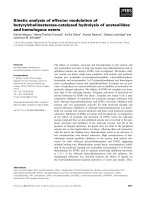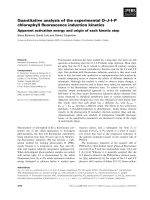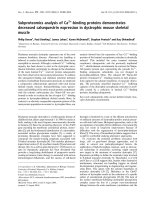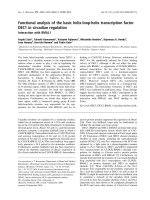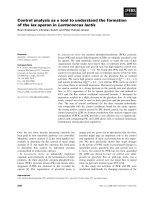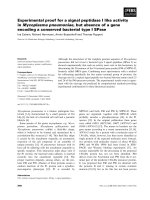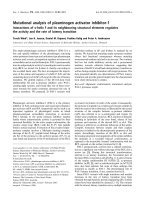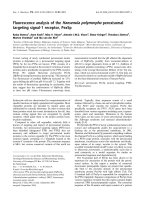Báo cáo khoa học: Proteome analysis of a rat liver nuclear insoluble protein fraction and localization of a novel protein, ISP36, to compartments in the interchromatin space pptx
Bạn đang xem bản rút gọn của tài liệu. Xem và tải ngay bản đầy đủ của tài liệu tại đây (575.43 KB, 12 trang )
Proteome analysis of a rat liver nuclear insoluble protein
fraction and localization of a novel protein, ISP36, to
compartments in the interchromatin space
Masashi Segawa
1
, Koko Niino
1
, Reiko Mineki
2
, Naoko Kaga
2
, Kimie Murayama
2
, Kenji Sugimoto
3
,
Yuichi Watanabe
4
, Kazuhiro Furukawa
1,5
and Tsuneyoshi Horigome
1,5,6
1 Natural Science Course, Graduate School of Science and Technology, Niigata University, Japan
2 Division of Proteomics and Biomolecular Science, Biomedical Research Center, Juntendo University Graduate School of Medicine, Tokyo,
Japan
3 Division of Applied Biochemistry, Graduate School of Agriculture and Biological Sciences, Osaka Prefecture University, Japan
4 Department of Biology, Niigata University, Japan
5 Department of Chemistry, Niigata University, Japan
6 Center for Transdisciplinary Research, Niigata University, Japan
In the interior of the cell nucleus, individual reactions
contributing to nuclear function occur at ‘specific
domains’, rather than in the whole nuclear interior. To
generate these specific domains, higher order organiza-
tion of the nuclear interior is necessary. Each chromo-
somal DNA is anchored to a specific ‘chromosome
territory’ and does not mix with other chromosomal
DNA in the nucleus [1]. It is known that proteins
important for particular nuclear functions are not
spread throughout the whole nuclear interior, but are
rather localized to specific compartments as speckles,
meshwork structures and so on [2]. Within the
compartments, proteins participating in a specific func-
tion are often present as a complex [2]. It is also
known that many protein complexes are recruited to,
stored in and function in interchromosomal compart-
ments [2]. Precise control of these subnuclear compart-
ment structures is crucial for nuclear functions.
The highly dynamic and flexible structures of the
nuclear interior compartments are based on the nuc-
lear envelope which is composed of nuclear mem-
branes, nuclear pore complexes (NPC) and the nuclear
lamina. Disruption of the integrity of the nuclear lam-
ina by mutation of lamin A ⁄ C causes Emery-Dreifuss
Keywords
ISP36, interchromatin space protein, nuclear
matrix protein, nuclear protein proteome,
insoluble protein proteome
Correspondence
T. Horigome, Department of Chemistry,
Faculty of Science, Niigata University,
Igarashi-2, Niigata 950-2181, Japan
Fax: +81 25 262 6160
Tel: +81 25 262 6160
E-mail:
(Received 27 March 2005, revised 4 July
2005, accepted 5 July 2005)
doi:10.1111/j.1742-4658.2005.04847.x
A rat liver nuclear insoluble protein fraction was analyzed to investigate
candidate proteins participating in nuclear architecture formation. Proteins
were subjected to two-dimensional separation by reversed-phase HPLC in
60% formic acid and SDS ⁄ PAGE. The method produced good resolution
of insoluble proteins. One hundred and thirty-eight proteins were separ-
ated, and 28 of these were identified. The identified proteins included one
novel protein, seven known nuclear proteins and 12 known nuclear matrix
proteins. The novel 36 kDa protein was further investigated for its sub-
nuclear localization. The human ortholog of the protein was expressed in
Escherichia coli and antibodies were raised against the recombinant protein.
Exclusive localization of the protein to the nuclear insoluble protein frac-
tion was confirmed by cell fractionation followed by immunoblotting.
Immunostaining of mouse C3H cells suggested that the 36 kDa protein
was a constituent of an insoluble macromolecular complex spread through-
out the interchromatin space of the nucleus. The protein was designated
‘interchromatin space protein of 36 kDa’, ISP36.
Abbreviations
DAPI, 4¢,6-diamidino-2-phenylindole; DMEM, Dulbecco’s modified Eagle’s medium; GFP, green fluorescent protein; ISP36, interchromatin
space protein of 36 kDa; NPC, nuclear pore complex; PMSF, phenylmethylsulfonyl fluoride; TFA, trifluoroacetic acid.
FEBS Journal 272 (2005) 4327–4338 ª 2005 FEBS 4327
muscular dystrophy and familial partial lipodystrophy
[3,4]. Mutations of an inner nuclear membrane protein,
emerin, also cause Emery-Dreifuss muscular dystrophy
[4]. These observations suggest that structural compo-
nents of the nuclear framework are important for the
structural integrity and functions of the nucleus [3,4].
By contrast, inner nuclear structures have been sup-
posed to be maintained by nuclear matrix filaments [5],
but such filaments have not yet been clearly demon-
strated in vivo and remain under debate [6,7]. Some
nuclear proteins present in the interior, such as actin
[8], lamins [9,10], NuMA [11,12] and the NPC-associ-
ated proteins Nup153 [13] and Tpr [14], are known to
form filaments or dot-like structures in the interior
of the nucleus. However, whether these proteins are
responsible for the inner nuclear structure is not yet
clear.
Recently, many integral nuclear membrane proteins
have been found by proteome analyses, and some of
these are thought to be linked to a variety of dystro-
phies [15]. These findings strongly suggest that the
structure and functions of the nuclear envelope are
more complicated than previously expected from lim-
ited protein members. Similar to the nuclear envelope,
it is likely that many unknown proteins participate in
maintaining the inner nuclear structures such as chro-
mosomal territories, interchromosomal compartments
and many kinds of speckles. Therefore, searches for
and analyses of novel nuclear structural proteins are
necessary to gain further insight into the inner nuclear
structure, nuclear compartmentalization and higher
order nuclear structure and functions.
In this study, we analyzed a rat liver nuclear insol-
uble protein fraction to search for candidate novel
nuclear structural proteins. High resolution over a
wide molecular mass range of insoluble proteins was
achieved by two-dimensional separation using poly-
mer-based reversed-phase HPLC in 60% formic acid
and SDS ⁄ PAGE. The separated proteins were identi-
fied by partial amino acid sequencing or MS, and con-
sisted of novel proteins along with many known
structural proteins. One of these novel proteins was
shown to be located to compartments in the interchro-
matin space in the nucleus. The protein is suggested to
be a constituent of an insoluble macromolecular com-
plex spread throughout the interchromatin space.
Results
We previously developed a reversed-phase HPLC sys-
tem using polymer-based columns for membrane pro-
tein separation [16]. Membrane fractions often contain
some proteins that are strongly bound to the columns
and can not be eluted by any solvents other than a
strong alkaline solution. Therefore, we optimized the
separation conditions for membrane proteins by using
a polymer-based column in the presence of 60% for-
mic acid [16]. The column can be washed with an alka-
line solution. We applied this method to the separation
of a rat liver nuclear insoluble protein fraction as fol-
lows. Rat liver nuclei were separated by sucrose
density gradient centrifugation and treated with
RNase A ⁄ DNase I to remove chromatin. The obtained
fraction contained the nuclear envelope and some of
the nuclear matrix proteins. This fraction was further
extracted with 2% (v ⁄ v) Triton X-100 ⁄ 0.3 m KCl to
remove lipids and proteins bound to the nuclear insol-
uble proteins by ionic and hydrophobic interactions.
The obtained ‘nuclear insoluble fraction’ was then dis-
solved in 100% formic acid, applied to a Poros 10R1
column and eluted with a linear gradient of n-butanol
in 60% (v ⁄ v) formic acid. The elution profile is shown
in Fig. 1A. The collected fractions were further separ-
ated by SDS ⁄ PAGE (Fig. 1B). One hundred and
thirty-eight components, including a protein as large as
217 kDa, were separated. Selected protein bands
derived from 21 mg of the nuclear insoluble fraction
were excised from the gel and digested with trypsin.
Next, the obtained peptides were separated by octyl-
silica reversed-phase HPLC and sequenced using a
protein sequencer. One example is shown in Fig. 2A.
Nineteen samples were analyzed by Edman degrada-
tion and 15 samples could be identified from the
obtained partial amino acid sequences and the mole-
cular masses estimated by SDS ⁄ PAGE (Table 1). Pep-
tides derived from samples < 10 lg were determined
by peptide mass finger printing (Table 1). Eighteen
samples were analyzed using the method and 14 sam-
ples could be identified. In the case of band 2 in
Fig. 1B, the partial amino acid sequences were further
confirmed by MS ⁄ MS analysis (Fig. 2B). As shown in
Table 1, many filament proteins were identified in the
nuclear insoluble protein fraction. The major compo-
nents found in Fig. 1B, i.e. bands 7, 8, 13, 17, 19, 23
and 25, were lamin A, lamin C, lamin B1, vimentin,
keratin type 2, keratin type 1 and actin, respectively,
which are all filament proteins. Uricase (band 15 in
Fig. 1B) probably represented a contaminating protein
derived from peroxisome cores, because peroxisome
cores are composed of uricase protein crystals, often
contaminate heavy subcellular fractions such as rough
microsomes and are not solubilized by mild detergents
[17]. We found a novel protein of 36 kDa, correspond-
ing to bands 2 in Fig. 1B. A cDNA sequence encoding
the 36 kDa protein was found in the Universal Protein
Resource database (UniProt accession no. Q96QD9).
Interchromatin space protein ISP36 M. Segawa et al.
4328 FEBS Journal 272 (2005) 4327–4338 ª 2005 FEBS
However, the protein had not yet been characterized,
although it was referred to as ‘putative 40-2-3 protein’.
Therefore, we further determined the localization of
this protein in the nucleus as described below. The
other proteins are discussed in detail in the Discussion.
Predicted amino acid sequences for the murine,
human and bovine 36 kDa protein (no. 2 in Table 1)
were found in the UniProt database. The amino acid
sequence of the human ortholog is shown in Fig. 3A.
We designated the protein as ‘interchromatin space
protein of 36 kDa’ (ISP36), because the protein was
shown to be localized to compartments in the inter-
chromatin space by the results presented below. ISP36
is a basic protein with a calculated isoelectric point of
12.5, and contains nuclear localization signal motifs, a
helix-turn-helix DNA-binding motif and an intermedi-
ate filament protein-like structure as shown in Fig. 3A.
The amino acid sequences of the human, mouse and
bovine ISP36 were very similar, as shown in Fig. 3B.
Therefore, we used human ISP36 to raise antibodies
against the protein. Human ISP36 was expressed as a
His
6
-tagged protein in Escherichia coli and purified by
Ni-agarose affinity chromatography in the presence of
8 m urea because the expressed protein formed inclu-
sion bodies (Fig. 4A). The purified protein was used to
raise antibodies in rabbits. The generated antiserum
reacted with the antigen, i.e. His
6
-tagged human ISP36
(Fig. 4, B3). The antiserum was then applied to the rat
liver nuclear insoluble fraction from which ISP36 was
originally purified. As shown in Fig. 4B, a 36 kDa
protein was clearly stained with the anti-ISP36 serum.
These results indicate that the antibodies raised against
human ISP36 cross-react with rat ISP36, and that
ISP36 is really present in the rat liver nuclear insoluble
fraction. Next, we determined the subcellular localiza-
tion of ISP36 using the antibodies and the rat liver
subcellular fractions. As shown in Fig. 5A, ISP36 was
localized to the nuclear fraction (Fig. 5A, ‘Anti ISP36’
lane 4). Moreover, the protein was completely localized
to the insoluble fraction among the subnuclear frac-
tions (Fig. 5B, ‘Anti ISP36’ lane 8).
As shown in Fig. 5A, affinity-purified anti-ISP36
specifically reacted with ISP36. Therefore, we applied
the antibodies to immunostaining of cultured cells.
When mouse C3H cells were stained with affinity-puri-
fied anti-ISP36, the cell nuclei were specifically stained
with speckles (Fig. 6). When the ISP36 staining was
compared with the DNA staining, the ISP36 speckles
were dense in regions where the DNA was weakly
stained (Fig. 6, 2 and 3). When immunoglobulin frac-
tions prepared from the preimmune rabbit were used
instead of the affinity-purified anti-ISP36, no staining
was observed (Fig. 6, 1). These results suggested that
ISP36 was present in compartments in the interchro-
matin space. When green fluorescent protein (GFP)–
ISP36 was transiently expressed in mouse C3H cells,
the fusion protein was completely localized to the nuc-
lei (Fig. 7) and appeared as speckles similar to the
immunostaining of ISP36 in Fig. 6. Within the nuc-
leus, the protein again seemed to be localized to
compartments in the interchromatin space (Fig. 7).
To further confirm the localization of ISP36, an inter-
Fig. 1. Elution profile of a nuclear insoluble
fraction from a Poros-HPLC column. (A) A
rat liver nuclear insoluble fraction (7 mg)
was applied to a Poros 10R1 column
(7.5 · 75 mm, 10 lm porous polystyrene
beads; PerSeptive Biosystems, Cambridge,
MA, USA) buffered with solvent A (60% for-
mic acid, 0.1% TFA, v ⁄ v) and eluted with a
140-min linear gradient from 5 to 40% of
Solvent B (33% n-butanol, 60% formic acid,
0.1% TFA, v ⁄ v) at 1.5 mLÆmin
)1
. Next, the
concentration of Solvent B was brought to
100% in 5 min. The eluate was fractionated
as indicated. (B) 1 ⁄ 100 volumes of the frac-
tions were analyzed by 8.5% SDS ⁄ PAGE,
and the gel was stained with silver. The
positions of the molecular mass standards
are shown on the left. The numbered pro-
tein bands were identified by amino acid
sequencing or MS after tryptic digestion.
M. Segawa et al. Interchromatin space protein ISP36
FEBS Journal 272 (2005) 4327–4338 ª 2005 FEBS 4329
chromatin granule cluster protein, SC35, was costained
with ISP36 (Fig. 8). The antibody staining patterns
were processed using a deconvolution method to
improve the images. Most of the SC35 speckles (green)
were colocalized with the ISP36 staining (red) in the
interphase cell nuclei, such that the color became yel-
low (Fig. 8). These results confirmed the presence of
ISP36 in compartments in the interchromatin space.
To precisely examine the localization of ISP36 in the
cell cycle, we observed cell nuclei in the different cell-
cycle stages (Fig. 9). As shown in Fig. 9, chromatin
stained by 4¢,6-diamidino-2-phenylindole (DAPI; blue)
and ISP36 stained with anti-ISP36 (red) were com-
pletely separate within the nucleus. When two daugh-
ter cells in early G
1
phase were observed from the
upper side, chromatin and ISP36 were present as
speckles without overlapping (Fig. 9, panel 1). These
staining patterns showed that ISP36 may be con-
strained as a constituent of an insoluble macromole-
cular complex spread throughout the interchromatin
space. In prophase, ISP36 staining was partly lost
in the interchromatin regions but accumulated in a
limited area (Fig. 9, panel 5). In prometaphase and
metaphase, ISP36 staining was excluded from the
interchromatin region and found in the periphery of
condensed chromosomes (Fig. 9, panels 6 and 7).
Some of the ISP36 did not diffuse into the cytoplasm
and remained near the chromosomes. These results
suggest that ISP36 may still be a constituent of some
macro-structure. In anaphase, most ISP36 disappeared
from the near-chromosomal region (Fig. 9, panel 8).
Taking the results of the immunostaining and GFP–
ISP36 expression together, we conclude that ISP36 is a
protein present in compartments in the interchromatin
space and may be a constituent of an intranuclear
structure that is spread throughout the sinusoidal
interchromatin space.
Discussion
We used a perfusion-type polystyrene resin column to
separate the nuclear insoluble protein fraction in the
presence of 60% (v ⁄ v) formic acid because the system
exhibits high resolution for membrane protein separ-
ation [16]. In addition, column maintenance is easier
than for a silica-based column, because the column
can be cleaned with 0.5 m NaOH and still maintain
high resolution. The column showed high resolution in
the separation of nuclear insoluble proteins (Fig. 1).
Protein recovery was expected to be high, because
recoveries of > 70% have been shown previously, even
for membrane proteins > 140 kDa [16]. Partial amino
acid sequencing with a protein sequencer and a peptide
mass finger printing method using MS were applied to
identify the proteins separated by this method
(Table 1). If greater amounts of starting material are
used, more proteins of lower abundance may be identi-
fied because the reverse-phase HPLC system can easily
be scaled up. This method should therefore be applic-
able to other proteome analyses of insoluble protein
fractions.
The proteins identified in this study could be classi-
fied into five groups as shown in Table 1. Group A
contains proteins that are known to be nuclear matrix
Fig. 2. Identification of proteins by partial amino acid sequencing
(A) and MS (B). (A) Twenty micrograms of protein 7 in Fig. 1B was
digested in-gel with trypsin, and the generated peptides were
applied to a reversed-phase HPLC equipped with an octylsilica col-
umn (4.8 · 250 mm; Capcel Pack, Shiseido, Tokyo). The peptides
were eluted with a linear gradient of 5–75% (v ⁄ v) acetonitrile con-
taining 0.1% (v ⁄ v) TFA at 0.4 mLÆmin
)1
. The amino acid sequences
of the separated peptides numbered 1–3 were determined using
a 470A Protein Sequencer (Applied Biosystems). (B) Three micro-
grams of protein 2 in Fig. 1B was digested in-gel with trypsin, and
the tryptic peptides were analyzed using an API QSTAR Pulsar
(Applied Biosystems) equipped with a micro-HPLC. The total ion
chromatogram and amino acid sequences estimated by MS ⁄ MS
analysis are shown.
Interchromatin space protein ISP36 M. Segawa et al.
4330 FEBS Journal 272 (2005) 4327–4338 ª 2005 FEBS
proteins. Filamentous proteins listed in Table 1, i.e.
lamin B1, lamin A, lamin C, vimentin, keratin types 1
and 2 and actin, were all included in this group.
Lamins are known to form a meshwork structure
underneath the inner nuclear membrane and function
to maintain the nuclear architecture [3]. The majority
of vimentin may be bound to the nuclear lamina from
the outside the nucleus [18]. The presence of actin in
the nucleus has been demonstrated by immunogold
staining with partial digestion of the surface lamina of
the nuclear matrix to allow penetration of the gold
particles into the nuclear matrix [19] and the export
mechanism from the nucleus has been well character-
ized [20]. Nuclear actin may be involved in the regula-
tion of nuclear processes, such as chromatin
remodeling [21]. LAP1 is an intrinsic inner nuclear
membrane protein that participates in anchoring the
nuclear lamina to the inner nuclear membrane [22].
ZAN 75 protein was recently reported to associate
with the nuclear matrix [23] and function as a tran-
scriptional activator [24]. Group B contains proteins
that are known to be present in the nucleus, but have
not yet been reported to be present in the nuclear mat-
rix fraction. It was recently reported that a protein
Table 1. Proteins identified by partial amino acid sequencing or MS. The proteins identified in the rat liver nuclear insoluble fraction are sum-
marized. Each ‘No.’ corresponds to that in Fig. 1B. ‘UniProt Accession no.’ shows the accession number in the Universal Protein Resource
Database. ‘Molecular mass’ values were obtained from the amino acid sequences. ‘S’ and ‘M’ under ‘Identification’ indicate identification by
partial amino acid sequencing with a protein sequencer and peptide mass finger printing, respectively. ‘No. of peptides’ indicates the number
of peptides of which partial amino acid sequences were determined. Proteins 2, 20 and 28 were further confirmed by amino acid sequen-
cing via nanoelectrospray ionization and quadrupole time-of-flight mass spectrometry. Grouping of identified proteins. A, Proteins that are
known to be nuclear matrix proteins; B, proteins that are known to be nuclear proteins; C, proteins that have not previously been reported
to be present in the nucleus; D, proteins derived from contaminating organelles, namely peroxisomes; and E, novel proteins found in this
study.
No. Protein
UniProt
Accession no.
Molecular
mass (kDa) Identification
No. of
peptides
Sequence
coverage (%) Group
1 Heterogeneous nuclear ribonucleoprotein G P84586, P38159 42 S 2 – B
2 36 kDa protein (ISP36) Q96QD9 36 M 4 68 E
3 Ribosomal protein L6 P21533 34 M – 59 B
4 Zn finger protein 75 P84587, P51815 75 S 2 – A
5 Peptidyl-prolyl-cis-trans isomerase B precursor P24368 23 M – 69 A
6 Fragment of lamin A or C P48679, P11516 36, 48 M – 43, 32 A
7 Lamin A P48679 74 S 2 – A
8 Lamin C or lamin A fragment P11516, P48679 65 S 1 – A
9 Fragment of lamin A or C P48679, P11516 74,65 S 1 – A
10 Fragment of lamin A or C P48679, P11516 47, 36 M – 51, 42 A
11 Fragment of lamin A or C P48679, P11516 65 M – 64 A
12 ATP binding cassette, subfamily C, member 2 Q5T2B1 175 M – 29 C
13 Lamin B1 P70615 66 S 3 – A
14 Nuclear pore complex protein 98 P49793 98 M – 31 B
15 Uricase P09118 35 S 1 – D
16 Heterogeneous nuclear ribonucleoprotein M Q62826 77 S 2 – A
17 Vimentin P31000 54 S 1 – A
18 Keratin, type 2 cytoskeletal 8 Q10758 54 M – 81 A
19 Keratin, type 2 cytoskeletal 8 Q10758 54 S 1 – A
20 Interleukin enhancer binding factor 3 Q9JIL3 98 M 12 48 B
21 Keratin, type 1 cytoskeletal 18 Q5BJY9 47 M – 58 A
22 Heat shock cognate P84588
71 kDa protein P63018 71 S 1 – B
23 Keratin, type 1 cytoskeletal 18 P05784 47 S 1 – A
24 Actin-binding protein ACF7, neural isoform 2 7513586
a
217 M – 25 C
25 Actin (a, b or c) P68134, P60710
P63259
42 S 1 – A
26 Lamina-associated polypeptide 1b Q5PQX1 67 S 2 – A
27 ATP binding RNA helicase C06E 1.10 P34305 130 S 1 – A
28 Nuclear pore complex protein 160 Q9Z0W3 160 M 5 13 B
29 Importin b-1 subunit P70168 98 M – 30 B
a
Accession no. in the NCBI protein database.
M. Segawa et al. Interchromatin space protein ISP36
FEBS Journal 272 (2005) 4327–4338 ª 2005 FEBS 4331
complex containing Nup160 functions to anchor the
NPC to the chromatin during NPC reconstitution in
late anaphase to early telophase in mitosis, because
depletion of the protein complex from a nuclear recon-
stitution system caused loss of NPC in the reconstitu-
ted nuclear envelope [25]. NPC protein 98 binds to the
protein complex [25]. Therefore, these proteins seem to
have requisite functions for NPC reconstitution on
chromatin. Another group B protein, heterogeneous
nuclear ribonucleoprotein G, functions in alternative
splicing [26]. Interleukin enhancer-binding factor 3
binds protein-arginine methyltransferase and contains
double-stranded RNA-binding motifs [27]. It is not yet
known whether these insoluble nuclear proteins partici-
pate in nuclear architecture formation. Further charac-
terization of these proteins will prove interesting.
Group C contains proteins that have not previously
been reported to be present in the nucleus. ATP-bind-
ing cassette, subfamily C, member 2 (mrp2) is a mem-
ber of the multidrug resistance protein family [28].
Most members of this family of proteins are located
only in plasma membrane, but one member is also
located in intracellular vesicles [28]. Actin-binding pro-
tein ACF7, neural isoform 2, is a member of the
dystonin subfamily and the beta-spectrin superfamily
Fig. 3. Amino acid sequence of human ISP36. (A) The amino acid
sequence of human ISP36 (GenBank Accession no. AJ344096).
Motifs found in the sequence by programs, ‘
PROFILE’and‘MOTIF FIN-
DER
’, were underlined. (B) Amino acid sequence identities between
human ISP36 and its orthologs. The percentages of identical and
similar amino acids are indicated.
Fig. 4. Preparation of an anti-ISP36 serum. (A) Expression of human His
6
-ISP36 in E. coli and its purification using Ni-agarose beads. A1 and
A2 are lysates of E. coli transformed with the pET28c plasmid encoding His
6
-ISP36 before and after ISP36 induction, respectively. A3 con-
tains 1 lgofHis
6
-ISP36 purified by Ni-agarose beads. A1–A3 are stained with Coomassie Brilliant Blue. A4–A6 are the same as A1–A3
except that the samples were blotted onto a nitrocellulose sheet, incubated with anti-His sera and then alkaline phosphatase-conjugated sec-
ondary antibodies, and developed with 5-bromo-4-chloro-3-indolyl phosphate. (B) Purified His
6
-ISP36 (B1–B3) and a rat liver nuclear insoluble
fraction (B4–B6) were electrophoresed and stained with Coomassie Brilliant Blue (B1 and B4) or transferred to a nitrocellulose sheet (B2,
B3, B5 and B6) followed by immunostaining. For the immunostaining, nitrocellulose strips were incubated with 200-fold diluted anti-ISP36
serum (B3 and B6) or preimmune serum (B2 and B5) and then alkaline phosphatase-conjugated anti-(rabbit IgG), and developed as in (A).
The arrowheads indicate ISP36. The bars at the left of panels indicate the positions of marker proteins of 97, 66, 43 and 29 kDa from top to
bottom.
Interchromatin space protein ISP36 M. Segawa et al.
4332 FEBS Journal 272 (2005) 4327–4338 ª 2005 FEBS
[29]. This protein functions in cytoplasmic microtubule
dynamics to facilitate actin–microtubule interactions
[29]. The majority of this protein is located in cytoplas-
mic filaments [29], and whether a proportion of this
protein is localized to the nucleus to interact with nuc-
lear actin needs to be examined.
Group D contains a protein that appears to be a
contaminant from peroxisomes as mentioned in the
Results section [17].Group E in Table 1 contains the
36 kDa protein. The36 kDa protein was characterized
in this study and designated ISP36. ISP36 was locali-
zed to compartments in the interchromatin space
(Figs 6–9). The interchromatin space starts at the nuc-
lear pores [30], and expands between chromatin terri-
tories and into their interior [1]. The surfaces of
compact chromatin domains provide a functionally
relevant barrier that can be penetrated by single pro-
teins or small protein aggregates, but not by larger
macromolecular complexes above a certain threshold
size [1]. Therefore, ISP36 is suggested to be a constitu-
ent of an insoluble macromolecular complex spread
throughout the interchromatin space, because: (a) the
protein was fractionated into the nuclear insoluble
fraction in the native state (Fig. 5); (b) the protein was
A
B
Fig. 5. Subcellular localization of ISP36. (A) Rat liver cytosol (A1),
microsome (A2), mitochondria (A3) and nuclear (A4) fractions were
electrophoresed, transferred to nitrocellulose sheets and then incu-
bated with preimmune IgG fraction or affinity-purified anti-ISP36
sera. After incubation with peroxidase-conjugated secondary anti-
bodies, the sheets were developed with H
2
O
2
and diaminobenzi-
dine. (B) A rat liver nuclear fraction was treated with DNase–RNase
and the solubilized fraction (chromatin fraction, B5) was separated
by centrifugation. The pellet was extracted with 0.5
M NaCl (salt
extract fraction, B6) and 2% (v ⁄ v) Triton X-100, 0.3
M KCl (Tx ⁄ KCl
extract fraction, B7), followed by separation of the insoluble fraction
(insoluble fraction, B8). These factions were immunoblotted as in
(A). The details of the fractionation are described in the Experimen-
tal Procedures. Molecular mass markers are same as in Fig. 4.
Fig. 6. Immunostaining of mouse C3H cells with anti-ISP36 serum.
Mouse C3H cells cultured on glass coverslips were treated with
preimmune IgG fraction (1) or affinity-purified anti-(human ISP36)
sera (2 and 3) and then stained with Cy3-conjugated anti-(rabbit
IgG). After counterstaining of DNA with DAPI, the cells were
observed by fluorescence microscopy. The round structure in the
DAPI staining corresponds to a cell nucleus. Bar, 10 lm.
Fig. 7. Localization of GFP–ISP36 protein transiently expressed in
mouse C3H cells. A plasmid harboring GFP-tagged ISP36 cDNA
was transfected into mouse C3H cells and the GFP–ISP36 protein
was transiently expressed. The cells were immobilized, and the
DNA was stained with DAPI and observed by fluorescence micros-
copy. The round structure in the DAPI staining corresponds to a cell
nucleus. Bar, 10 lm.
M. Segawa et al. Interchromatin space protein ISP36
FEBS Journal 272 (2005) 4327–4338 ª 2005 FEBS 4333
localized to compartments in the interchromatin space
by anti-ISP36 staining (Figs 8 and 9); (c) the immuno-
staining did not expand into the chromosomal com-
partment or the cytoplasm (Figs 8 and 9); and (d)
some ISP36 did not diffuse into the cytoplasm and
remained near chromatin in metaphase (Fig. 9, panel
7). The interchromatin space contains other macro-
molecular complexes that are required for replication,
translation, splicing and repair [1,31]. Therefore, ISP36
may also participate in these nuclear functions. We
examined the in vitro DNA binding ability of ISP36
expressed in E. coli because the protein contains a
helix-turn-helix DNA-binding motif (Fig. 3). ISP36
bound to a nonspecific double-stranded DNA frag-
ment in 0.14 m KCl, although the binding strength
was moderate, i.e. bound DNA was dissociated by
0.2 m KCl (data not shown). To elucidate the function
of this novel protein in compartments in the interchro-
matin space, analyses of its dynamics using GFP–
ISP36 and searches for binding proteins both in vivo
and in vitro are necessary as the next step.
Experimental procedures
Buffers
Buffers were as follows. Buffer A: 10 mm Tris ⁄ HCl,
pH 7.4, 0.2 mm MgSO
4
;8m urea buffer: 10 mm Tris, 8 m
urea, 0.1 m NaH
2
PO
4
, pH 8.0; NaCl ⁄ P
i
: 1.5 mm NaH
2
PO
4
,
8.1 mm Na
2
HPO
4
, 145 mm NaCl.
Animals
Animal care, housing and killing were in accordance with the
guidelines of the Ministry of Education, Science, Sports and
Culture of Japan for the use of laboratory animals.
Cell fractionation
Subcellular fractions of rat liver were prepared as described
previously [32].
Fig. 8. Localization of ISP36 and SC35 in mouse C3H cell nuclei.
Mouse C3H cells in interphase were stained by affinity-purified
anti-ISP36 as in Fig. 6 (red). An SR splicing factor, SC35, which is
known to be present in interchromatin granule clusters within the
interchromatin space, was stained with an monoclonal anti-SC35
serum (aSC35; BD Biosciences) followed by FITC-labeled anti-
(mouse IgG) (green), and then observed by fluorescence micros-
copy. The digital image data of a Z series were captured using a
CCD camera, processed by deconvolution software (
AUTODEBLUR;
AUTOQUANT) and presented in 3D (VOLOCITY, IMPROVISION). The round
structure corresponds to a cell nucleus. Bar, 10 lm.
Fig. 9. Intranuclear localization of ISP36 throughout the cell cycle.
Mouse C3H cells were stained with affinity-purified anti-(human
ISP36) sera (red) and DAPI (blue) as in Fig. 6, and then observed by
fluorescence microscopy. The digital image data were processed
as in Fig. 8. 1, 2: early G
1
;3,4:G
2
to prophase; 5: prophase; 6: pro-
metaphase; 7: metaphase; and 8: anaphase. 2 and 4 represent side
views of stained nuclei. Bars, 10 lm.
Interchromatin space protein ISP36 M. Segawa et al.
4334 FEBS Journal 272 (2005) 4327–4338 ª 2005 FEBS
Preparation of rat liver subnuclear fractions
Rat liver nuclei were isolated from fasting rats as described
previously [33]. Next, the isolated nuclei were suspended in
50 mm Tris ⁄ HCl buffer, pH 7.4, containing 0.25 m sucrose,
5mm MgSO
4
, and proteinase inhibitors i.e. 1 mm phenyl-
methylsulfonyl fluoride (PMSF), 2 mm benzamidine,
10 lgÆmL
)1
of leupeptin and 5 lgÆmL
)1
each of antipain,
chymostatin and pepstatin A (150–300 U nucleiÆmL
)1
). The
amount of material derived from one A
260
unit and 1 mL
of isolated nuclei ( 3 · 10
6
nuclei) was defined as 1 unit
(1 U). The suspension was treated with DNase I and RN-
ase A (final concentration of 125 lgÆmL
)1
for each enzyme)
at 4 °C for 2 h and then centrifuged at 800 g for 15 min.
The supernatant was designated the ‘chromatin fraction’.
The pellet was suspended in buffer A (10 mm Tris ⁄ HCl,
pH 7.4, 0.2 mm MgSO
4
) containing protease inhibitors, and
the concentration was adjusted to 167 UÆmL
)1
. The suspen-
sion was added to 4 vol. of buffer A containing 625 mm
NaCl, protease inhibitors and a 1 ⁄ 25 vol. of 2-mercapto-
ethanol. After incubation for 30 min, the suspension was
centrifuged at 10 000 g for 15 min. The supernatant was
designated the ‘salt extract fraction’. The pellet was washed
with buffer A containing 500 mm NaCl and then suspended
in buffer A containing protease inhibitors, followed by
adjustment of the volume to 500 UÆmL
)1
. The suspension
was added to an equal volume of 40 mm Mes ⁄ KCl, pH 6.0,
4% (v ⁄ v) Triton X-100, 0.6 m KCl, 20% (w ⁄ v) sucrose,
4mm EDTA containing protease inhibitors and incubated
for 30 min. The suspension was centrifuged at 20 000 g for
30 min. The supernatant and pellet were designated the
‘Tx ⁄ KCl extract fraction’ and ‘insoluble fraction’, respect-
ively.
Purification and identification of proteins in the
nuclear insoluble fraction
Proteins in the rat liver nuclear insoluble fraction were sep-
arated by reversed-phase HPLC in 60% (v ⁄ v) formic acid,
followed by SDS ⁄ PAGE as described previously [16]. For
the view of protein elution pattern, gels were stained by sil-
ver (Fig. 1B). However, for further analysis of interesting
proteins, gels were stained with Coomassie Brilliant Blue
and protein bands were excised from the gel. The excised
proteins were identified by mass spectrometry or partial
amino acid sequencing using a protein sequencer. Samples
obtained in quantities > 10 lg were identified by the se-
quencer. Tryptic digestion of the proteins excised from the
gel was performed as described previously [34]. The mix-
tures of tryptic peptides were completely dried by vacuum
centrifugation, and then dissolved in 2% (v ⁄ v) trifluoroace-
tic acid (TFA). Next, peptide mapping was performed using
a model TSQ 700 triple-stage electrospray ionization quad-
rupole mass spectrometer (Thermo Electron, San Jose, CA,
USA) with a Gilson HPLC system (Gilson, Villiers-le-Bel,
France). The HPLC conditions were as follows: Magic C
18
column (0.2 · 50 mm; Michrom BioResource, Auburn,
CA) eluted with 0.1% (v ⁄ v) formic acid (solvent C) and
0.1% (v ⁄ v) formic acid in 90% (v ⁄ v) CH
3
CN (solvent D),
using a program of 5% (v ⁄ v) solvent D for 5 min, a gradi-
ent of 1.05% per min for 90 min and 100% solvent D for
5 min, at a flow rate of 2 lLÆmin
)1
using an Accurate split-
ter (1 : 100 v ⁄ v; LC Packing, San Francisco, CA, USA).
The MS conditions were as follows: ion spray voltage of
2.2–2.7 kV, electron multiplier voltage of 1000 eV, and
mass range of 220–2500 (4 s). The proteins were identi-
fied using the prowl search engine (wl.
rockefeller.edu/) and the NCBI database. The API QSTAR
pulsar hybrid mass spectrometer system, consisting of
nanoelectrospray ionization and quadrupole time-of-flight,
with a microliquid chromatograph (Magic 2002; Michrom
BioResource) was used for MS ⁄ MS analysis to confirm the
amino acid sequences of the peptides. The MS conditions
for MS ⁄ MS analysis were as follows: ion spray voltage of
3.0–3.8 kV, electron multiplier voltage of 2200 V, nitrogen
10 unit curtain gas, nitrogen 10 unit collision gas and colli-
sion energy of 20–55 eV.
In cases of partial amino acid sequencing, the peptides
generated from the protein were purified by octylsilica
reversed-phase HPLC and the partial amino acid sequences
were determined using a 470A Protein Sequencer (Applied
Biosystems). Proteins were identified from their molecular
masses and the obtained partial amino acid sequences using
the program fasta ( />DNA constructs
ISP36 cDNA clones for protein expression were prepared
using the full-length human ISP36 cDNA sequence. A
human ISP36 cDNA clone in pSPORT1 (clone ID:
DKFZp761B1514; RZPD Deutsches Ressourcenzentrum
fur Genomforschung GmbH, Berlin, Germany) was used as
a template for PCR with the following synthetic oligo-
nucleotide primers: N, 5¢-CATGAACCGGTTTGGTAC-3¢
as the 5¢ primer, and C, 5¢-CTATCCCACGGTGACAA
AGC-3¢ as the 3¢ primer. The sequence between these prim-
ers was amplified by PCR using Ex Taq DNA polymerase
(Takara, Tokyo, Japan). The PCR product was digested
with HindIII and XhoI, and the resulting DNA fragment
was inserted into the HindIII ⁄ XhoI sites of pET28c for
His
6
-tagged protein expression (Novagen, Madison, WI,
USA), or the HindIII ⁄ SalI sites of pEGFP-C2 for GFP-
tagged protein expression (Clontech, Mountain View, CA,
USA), resulting in pEGFP-ISP36.
Expression and purification of His
6
-ISP36
The pET28c expression plasmid encoding His
6
-ISP36 was
transformed into E. coli DE3 (BL21) cells, and the cells
were grown in Luria–Bertani medium. Expression of the
M. Segawa et al. Interchromatin space protein ISP36
FEBS Journal 272 (2005) 4327–4338 ª 2005 FEBS 4335
fusion protein was induced by addition of 0.1 mm isopropyl
thio-b-d-galactoside, followed by incubation for 6 h at
30 °C. The bacterial cells were collected and disrupted by
sonication, resulting in the recovery of ISP36 as inclusion
bodies in the precipitate fraction. Next, the inclusion bodies
were dissolved in 10 mm Tris, 8 m urea, 0.1 m NaH
2
PO
4
,
pH 8.0 (8 m urea buffer), and the resulting supernatant was
loaded onto a column (1.4 · 2 cm) packed with 2 mL of
Ni-NTA beads (Qiagen). The column was washed exten-
sively with 8 m urea buffer containing 10 mm imidazole
and the bound His
6
-ISP36 was then eluted with 8 m urea
buffer containing 1 m imidazole and stored at )80 °C until
use.
Preparation of rabbit anti-ISP36 sera
An anti-ISP36 serum was raised in female rabbits by
immunization with gel pieces containing His
6
-ISP36 and
Freund’s adjuvant [32]. The IgG fraction was purified from
the antiserum by ammonium sulfate precipitation.
Purification of anti-ISP36 sera
His
6
-ISP36 purified as above (about 3 mg) was dialyzed
against 0.9% (w ⁄ v) NaCl, and then precipitated by addition
of 4 volumes of cold acetone. The precipitate was dissolved
in 0.3 m triethanolamine ⁄ HCl, pH 8.0, 8 m urea, and reac-
ted with 1 mL Tresyl Sepharose 4B (Toso, Tokyo, Japan)
at room temperature for 2–3 days on a rotator. After incu-
bation with 0.1 m monoethanolamine, pH 8.0, 8 m urea at
room temperature for 1 h, the affinity resin bearing His
6
-
ISP36 was thoroughly washed with 20 mm Tris ⁄ HCl,
pH 8.0, 0.1% (w ⁄ v) SDS, 0.5 m NaCl. Immunoglobulin
fractions obtained from the anti-ISP36 serum were incuba-
ted with the affinity resin at 4 °C overnight. After washing
with 20 mm Tris ⁄ HCl, pH 7.0, 150 m m NaCl, 0.1% (v ⁄ v)
Triton X-100, the purified antibodies were eluted with
0.1 m glycine ⁄ HCl (pH 2.5) and immediately neutralized
with a Tris buffer.
Immunoblotting
Samples separated by SDS ⁄ PAGE were electrotransferred
onto a nitrocellulose filter. The filter was incubated with
1.5 mm NaH
2
PO
4
, 8.1 mm Na
2
HPO
4
, 145 mm NaCl
(NaCl ⁄ P
i
) containing 5% nonfat dry milk for 1 h, and then
with the same buffer containing the anti-ISP36 serum
(1 : 200, v ⁄ v) for 3 h, followed by three washes in NaCl ⁄ P
i
containing 0.05% (v ⁄ v) Tween-20 for 5 min each. The filter
was then incubated with horseradish peroxidase-conjugated
goat anti-(rabbit IgG) (1 : 1000, v ⁄ v) in NaCl ⁄ P
i
containing
5% (w ⁄ v) nonfat dry milk for 1 h, washed five times with
NaCl ⁄ P
i
containing 0.05% (v ⁄ v) Tween-20 for 5 min each,
and detected using H
2
O
2
and 3,3¢-diaminobenzidine.
Cell culture and immunofluorescence
Mouse C3H cells were grown in Dulbecco’s modified
Eagle’s medium (Nissui Pharmaceutical, Tokyo, Japan)
containing 10% (v ⁄ v) fetal bovine serum at 37 °Cina
5% (v ⁄ v) CO
2
atmosphere [34]. Aliquots of the cells
(1–3 · 10
5
) were grown on glass coverslips in 35 mm
dishes for 48 h, fixed with 4% paraformaldehyde for
20 min and treated with 0.1% (v ⁄ v) Triton X-100 for
5 min. The fixed cells were incubated with affinity-purified
anti-ISP36 sera or preimmune IgG (final concentration,
4 lgÆmL
)1
), and then with Cy3-conjugated goat anti-rabbit
sera (1 : 1500; Jackson Immunoresearch Laboratories,
West Grove, PA, USA). After counterstaining with DAPI
(1 lgÆmL
)1
), the cells were observed under a fluorescence
microscope (Eclipse E600; Nikon) equipped with a Plan-
Apo ·60 objective (NA 1.40; Nikon). Digital images were
obtained using luminavision software (Mac version 1.57;
Mitani Corp., Tokyo, Japan) controlling an ORCA-ER
cooled CCD camera (Hamamatsu Photonics, Shizuoka,
Japan) and a Z-axis motor (Ludl Electronic Products Ltd,
Hawthorne, NY, USA) for collecting Z-series optical sec-
tions (0.1 lm intervals).
Transient expression of GFP-ISP36
The pEGFP-ISP36 plasmid (16 l g) was mixed with
0.6 · 10
7
cells in 0.5 mL of 30 mm NaCl, 120 mm KCl,
8mm Na
2
HPO
4
, 1.5 mm MgCl
2
and electroporated into
mouse C3H cells in a cuvette with electrodes at 0.4 cm
intervals at a setting of 220 V and a 960 lF capacitor using
a Gene Pulser and Capacitance Extender (Bio-Rad, Hercu-
les, CA, USA). After the pulse, the electroporated cells
were incubated with an equal volume of serum-free MEM
(Nissui Pharmaceutical) for 10 min at room temperature,
and then aliquots of the cells were grown in an excess
amount of Dulbecco’s modified Eagle’s medium on glass
coverslips in 35 mm dishes for subsequent microscopic
observation.
Acknowledgements
This work was supported by a grant-in-aid from the
Ministry of Education, Science, Sports and Culture of
Japan and grants from the Biodesign Research Project
of RIKEN and for Project Research of Niigata Uni-
versity.
References
1 Cremer T & Cremer C (2001) Chromosome territories,
nuclear architecture and gene regulation in mammalian
cells. Nat Rev Genet 2, 292–301.
Interchromatin space protein ISP36 M. Segawa et al.
4336 FEBS Journal 272 (2005) 4327–4338 ª 2005 FEBS
2 Lamond AI & Spector DL (2003) Nuclear speckles: a
model for nuclear organelles. Nat Rev Mol Cell Biol 4,
605–612.
3 Hutchison CJ (2002) Lamins: building blocks or regula-
tors of gene expression? Nat Rev Mol Cell Biol 3, 848–
858.
4 Ostlund C & Worman HJ (2003) Nuclear envelope pro-
teins and neuromuscular diseases. Muscle Nerve 27,
393–406.
5 Nickerson JA (2001) Experimental observations of a
nuclear matrix. J Cell Sci 114, 463–474.
6 Pederson T (2000) Half a century of ‘the nuclear mat-
rix’. Mol Biol Cell 11, 799–805.
7 Martelli AM, Falcieri E, Zweyer M, Bortul R, Tabellini
G, Cappellini A, Cocco L & Manzoli L (2002) The
controversial nuclear matrix: a balanced point of view.
Histol Histopathol 17, 1193–1205.
8 Amankwah KS & De Boni U (1994) Ultrastructural
localization of filamentous actin within neuronal inter-
phase nuclei in situ. Exp Cell Res 210, 315–325.
9 Hozak P, Sasseville AMJ, Raymond Y & Cook PR
(1995) Lamin proteins form an internal nucleoskeleton
as well as a peripheral lamina in human cells. J Cell Sci
108, 635–644.
10 Jagatheesan G, Thanumalayan S, Muralikrishna B,
Rangaraj N, Karande AA & Parnaik VK (1999) Colo-
calization of intranuclear lamin foci with RNA splicing
factors. J Cell Sci 112 , 4651–4661.
11 Gueth-Hallonet C, Wang J, Harborth J, Weber K &
Osborn M (1998) Induction of a regular nuclear lattice
by overexpression of NuMA. Exp Cell Res 243, 434–
452.
12 Harborth J, Wang J, Gueth-Hallonet C, Weber K &
Osborn M (1999) Self assembly of NuMA: multiarm
oligomers as structural units of a nuclear lattice. EMBO
J 18, 1689–1700.
13 Codes VC, Reidenbach S, Kohler A, Stuurman N, van
Driel R & Franke WW (1993) Intranuclear filaments
containing a nuclear pore complex protein. J Cell Biol
123, 1333–1344.
14 Codes VC, Reidenbach S, Rackwitz HR & Franke WW
(1997) Identification of protein p270 ⁄ Tpr as a constitu-
tive component of the nuclear pore complex-attached
intranuclear filaments. J Cell Biol 136, 515–529.
15 Schirmer EC, Florens L, Guan T, Yates JR III &
Gerace L (2003) Nuclear membrane proteins with
potential disease links found by subtractive proteomics.
Science 301, 1380–1382.
16 Kikuchi N, Yamakawa Y, Ichimura T, Omata S &
Horigome T (1997) Reversed-phase high-performance
liquid chromatography of membrane proteins on perfu-
sion-type polystyrene resin columns in 60% formic acid.
Chromatography 18, 175–184.
17 Kreibich G, Ulrich BL & Sabatini DD (1978) Proteins
of rough microsomal membranes related to ribosome
binding. I. Identification of ribophorins I and II, mem-
brane proteins characteristic of rough microsomes.
J Cell Biol 77, 464–487.
18 Fey EG, Wan KM & Penman S (1984) Epithelial cyto-
skeletal framework and nuclear matrix-intermediate fila-
ment scaffold: three-dimensional organization and
protein composition. J Cell Biol 98, 1973–1984.
19 Nakayasu H & Ueda K (1985) Ultrastructural localiza-
tion of actin in nuclear matrices from mouse leukemia
L5178Y cells. Cell Struct Funct 10, 305–309.
20 Wada A, Fukuda M, Mishima M & Nishida E (1998)
Nuclear export of actin: a novel mechanism regulating
the subcellular localization of a major cytoskeletal pro-
tein. EMBO J 17, 1635–1641.
21 Rando OJ, Zhao K & Crabtree GR (2000) Searching
for a function for nuclear actin. Trends Cell Biol 10,
92–97.
22 Martin L, Crimaudo C & Gerace L (1995) cDNA clon-
ing and characterization of lamina-associated polypep-
tide 1C (LAP1C), an integral protein of the inner
nuclear membrane. J Biol Chem 270, 8822–8828.
23 Lee JY, Kambe M, Hayashi M & Takenaga K (1998)
Cloning and characterization of a novel zinc finger pro-
tein that associates with nuclear matrix. DNA Cell Biol
17, 849–858.
24 Lee JY, Nakane Y, Koshikawa N, Nakayama K,
Hayashi M & Takenaga K (2000) Characterization of a
zinc finger protein ZAN75: nuclear localization signal,
transcriptional activator activity, and expression during
neuronal differentiation of P19 cells. DNA Cell Biol 19,
227–224.
25 Walther TC, Alves A, Pickersgill H, Loiodice I, Hetzer
M, Galy V, Hulsmann BB, Kocher T, Wilm M, Allen T
et al. (2003) The conserved Nup107–160 complex is crit-
ical for nuclear pore complex assembly. Cell 113, 195–
206.
26 Nasim MT, Chernova TK, Chowdhury HM, Yue BG &
Eperon IC (2003) HnRNP G and Tra2beta: opposite
effects on splicing matched by antagonism in RNA
binding. Hum Mol Genet 12, 1337–1348.
27 Tang J, Kao PN & Herschman HR (2000) Protein-argi-
nine methyltransferase I, the predominant protein-argi-
nine methyltransferase in cells, interacts with and is
regulated by interleukin enhancer-binding factor 3.
J Biol Chem 275, 19866–19876.
28 Borst P, Evers R, Kool M & Wijnholds J (1999) The
multidrug resistance protein family. Biochim Biophys
Acta 1461, 347–357.
29 Karakesisoglou I, Yang Y & Fuchs E (2000) An epi-
dermal plakin that integrates actin and microtubule
networks at cellular junctions. J Cell Biol 149, 195–
208.
30 Visser AE, Jaunin F, Fakan S & Aten JA (2000) High
resolution analysis of interphase chromosome domains.
J Cell Sci 113, 2585–2593.
M. Segawa et al. Interchromatin space protein ISP36
FEBS Journal 272 (2005) 4327–4338 ª 2005 FEBS 4337
31 Lamond AI & Spector DL (2003) Nuclear speckles: a
model for nuclear organelles. Nat Rev Mol Cell Biol 4,
605–612.
32 Kawahire S, Tachibana T, Umemoto M, Yoneda Y,
Imai N, Saito M, Ichimura T, Omata S & Horigome T
(1996) Subcellular distribution and phosphorylation of
the nuclear localization signal binding protein, NBP60.
Exp Cell Res 222, 385–394.
33 Kita K, Omata S & Horigome T (1993) Purification
and characterization of a nuclear pore glycoprotein
complex containing p62. J Biochem (Tokyo) 113 , 377–
382.
34 Castellanos-Serra L, Proenza W, Huerta V, Moriz R &
Simpson R (1999) Proteome analysis of polyacrylamide
gel-separated proteins visualized by reversible negative
staining using imidazole-zinc salts. Electrophoresis 20,
732–737.
35 Sugimoto K, Tasaka H & Dotsu M (2001) Molecular
behavior in living mitotic cells of human centromere
heterochromatin protein HPLalpha ectopically
expressed as a fusion to red fluorescent protein. Cell
Struct Funct 26, 705–718.
Interchromatin space protein ISP36 M. Segawa et al.
4338 FEBS Journal 272 (2005) 4327–4338 ª 2005 FEBS

